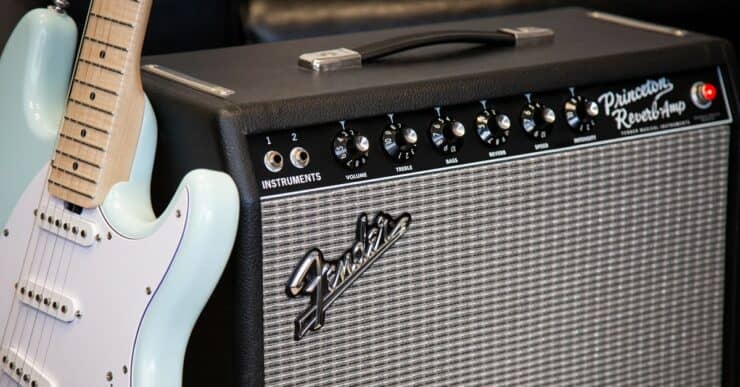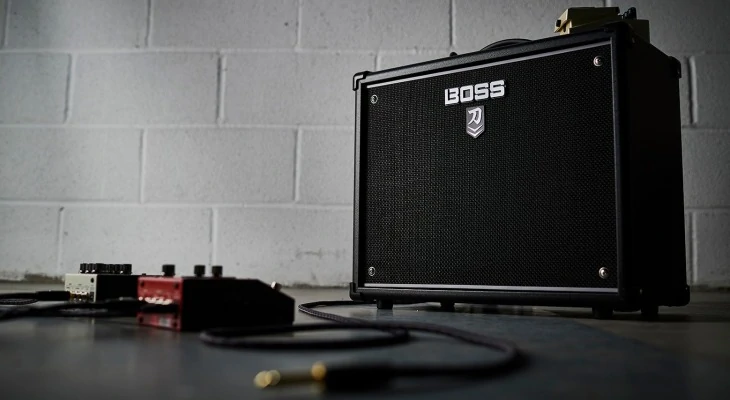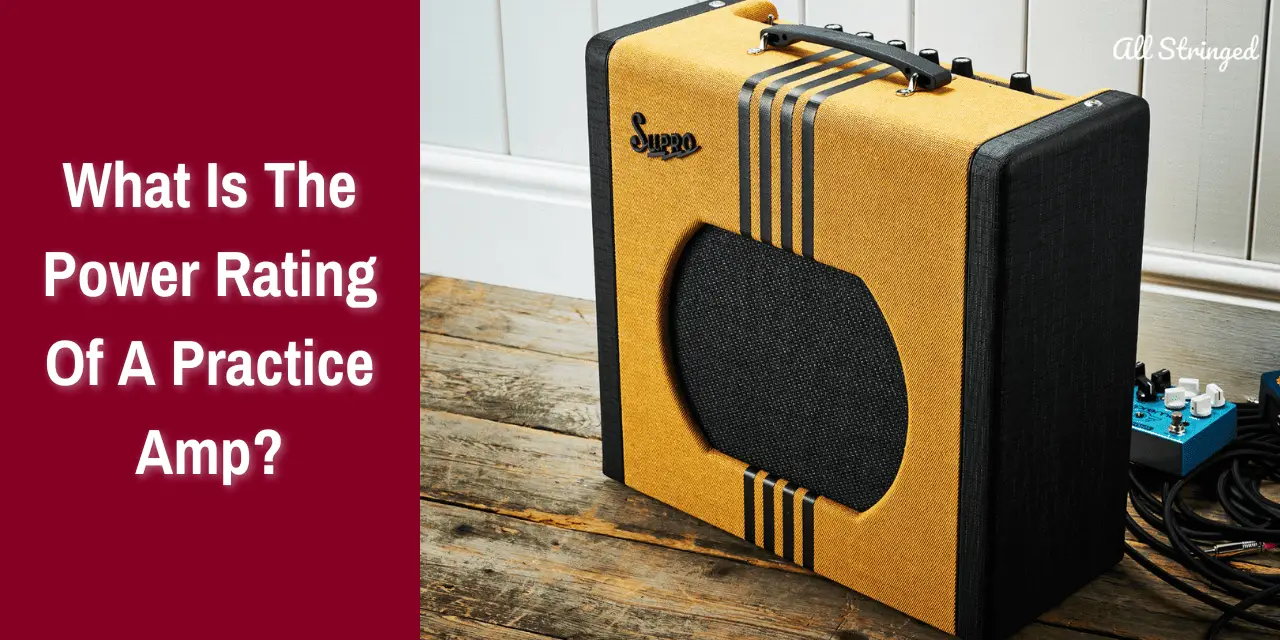Have you ever wanted to know what the power rating of a practice amp is? If so, you’re in luck! This article will provide an in-depth look at the power rating of a practice amp and what it means for guitar players. You’ll learn why it’s important to choose an amp with the right power rating and how to choose one that’s best suited to your needs. So, if you’re a guitar player looking to get the most out of your practice amp, read on!
What is the power rating in a practice amp?
A practice amp is an essential component of any guitarist’s gear. One of the crucial factors that influence the sound quality of the amp is its power rating. The power rating of a guitar amp refers to the maximum amount of power it can deliver to the speakers in watts. A higher power rating also means a louder and more powerful sound.
However, power rating is not the only factor that affects the sound of the guitar amp. There are other factors too, like the type and quality of the tubes, the speaker configuration, and the overall design of the amp. Nonetheless, understanding the power rating of a guitar amp will be crucial for any guitarist looking to achieve their desired sound.
ALSO READ: Best Practice Amp: Top 7 Picks to Play Anywhere!
When it comes to power rating, there are two types of guitar amps – low-wattage and high-wattage guitar amps. Low-wattage amps typically come with a power rating of 15W or less, whereas high-wattage amps can deliver up to 100W or more. The power rating affects the headroom, volume, and distortion of the amp.
Volume is the most obvious factor that is affected by the power rating. A high-wattage amp can produce a louder sound compared to a low-wattage amp. For instance, a 100W amp will be much louder than a 15W amp. Therefore, it is important that you choose the right power rating depending on the size of the venue you’ll be playing in and the type of music you’ll be playing.
Headroom is the next factor that is affected by power rating. Headroom refers to the amount of clean headroom or space that the amp has before it begins distorting. A high-wattage amp will typically have more headroom than a low-wattage amp. This means that it can handle higher volumes without distorting. It can be beneficial for guitarists who want a clean sound even at high volumes.
Distortion is the third factor affected by power rating. When the volume of the practice amp is pushed to its maximum, it’ll start to distort or break up, producing a distorted sound. A low-wattage amp can start to distort at lower volumes compared to a high-wattage amp. However, some guitarists prefer the sound of distortion and use this effect intentionally in their music.

Power ratings of practice amps
Practice amps are an important piece of equipment for guitarists who want to practice at home or in small venues. They’re typically smaller, less expensive, and less powerful than traditional studio amps, making them an ideal option for guitarists who are just starting or in need of a reliable, portable amp for practice sessions.
Typical power ratings of practice amps
The power rating of a practice amp typically ranges from 1W to 30W. The power rating of the practice amp will determine its volume and headroom. A 1W amp is perfect for bedroom practice, whereas a 30W amp can produce enough volume for playing with a band. However, it is important that you remember that wattage isn’t the only factor that affects volume. It is important that you consider other factors like size, portability, tone, and other quality of the amp when choosing a practice amp.
Factors to consider when choosing a practice amp
#1. Tone
The practice amp’s tone is the most important factor that you should consider when choosing a practice amp. It is important that you choose an amp that produces a tone that complements your playing style and the type of music you’re playing. Some amps are designed for specific genres such as metal or blues, whereas others offer a broader range of tones.
#2. Size and portability
Practice amps are generally small and portable, which makes them quite easy to carry around. However, it is essential that you choose an amp that is easy to transport and won’t take up too much space in the practice area. A small, lightweight amp will be ideal for people who need to move it around frequently.
#3. Features
Many practice amps come with added features such as built-in effects, auxiliary inputs, and headphones jacks. These features can make practice amps much easier to practice and record. Moreover, the features also add to the overall versatility of the amp.
#4. Price
Practice amps are typically less experience compared to studio amps, but the prices can vary significantly depending on the quality and features of the amp. It is essential that you choose an amp that fits your budget while also offering the features and sound quality you’re after.
#5. Brand reputation
The brand’s reputation can also be a key factor to consider when choosing a practice amp. Well-known brands like Fender, Marshall, and Vox have a reputation for manufacturing high-quality amps that offer wonderful tone and durability. However, there are also lesser-known brands capable of offering high-quality amps at a lower price point.

How to test a practice amp
Choosing a practice amp can be a particularly challenging task as there are various factors to consider, such as size, tone, price, features, and more. However, there are two essential ways that you must test out the practice amp before you purchase it – listen to the sound samples online and test the amp in person. This will allow you to test the practice amp and choose the best option that suits your needs.
Listening to sound samples
Listening to sound samples will be a great way of getting an idea of the tone and sound quality of the practice amp. Many online retailers, manufacturers, and online stores offer sound samples of their products. These samples will allow you to hear how the practice amp sounds in different settings and with different playing styles. This can be especially useful if you aren’t able to test the practice amp in person or if you’re looking to buy it online. When listening to sound samples, it is important that you listen for the following characteristics –
- Clarity – Is the sound crystal clear and defined, or does it sound muddy and indistinct?
- Dynamic range – Does the practice amp respond well to different playing styles, or does it sound the same regardless of how hard or soft you’re playing?
- Tone – Does the amp produce a tone that perfectly complements your playing style and the type of music you’re going to play?
Testing the amp in person
Testing the amp in person is widely considered to be the most reliable way to determine if the amp is right for you. When testing a practice amp in person, you must bring your guitar and any effects pedals you’re planning to use with the amp. This will allow you to hear how the amp sound with your gear and playing style. When you’re testing the amp in person, it’ll be important to consider the following factors –
- Volume – Does the practice amp produce enough volume for your needs, without distorting or sounding harsh?
- Features – Do the features of the practice amp meet your needs, such as auxiliary inputs, headphone jacks, and built-in effects?
- Tone – Does the amp produce a tone that perfectly complements your playing style and the type of music you play?
- Build quality – Is the amp durable and well-built, or does it feel flimsy or cheaply made?
- Price – Does the amp offer good value for the price, or will you be paying too much for the features and quality?
What is the ideal power rating for a beginner amp?
A decent guitar amp for a beginner is generally a solid-state amp with a speaker in the 8 to 12-inch range. These amps usually have a power rating of 10 to 20 watts. This is more than enough power for a beginner to get started. You should look out for features like onboard digital effects, distortion, reverb, and more.
There’s nothing wrong with choosing a more powerful amp as a beginner. The reason most guitarists choose smaller amps is that they are rather inexpensive. You can easily grab a decent-quality beginner’s amp for around $100 or so.
For serious beginners who are sure that they’ll stick to the instrument, there are affordable amps in the 50-100W range. These amps will allow you to practice and jam with friends, with some being loud enough to compete with the band drummer.
For typical beginners, it is recommended that they can go for something like the Marshall MG15. This amp has an 8-inch speaker and comes with a power rating of 15 watts. It also features some of the best distortions you can possibly get in a small amp. There’s also a usable 3-band EQ section. For a beginner, this is all that you really need. If you want reverb or digital effects, you can go for MG15 models available for a bit more money.
What is the power rating of a practice amp?
Many guitarists make their beginner amps their practice amps once they upgrade to a bigger main amp. A power rating of 10 to 20 Watts will be a decent range for a dedicated practice amp. Unlike amps for beginners, practice amps for seasoned pros need to include features that are more in line with their style and skill level.
The right practice amp is one that sounds great and inspires you to play. It doesn’t necessarily need to be big or powerful, although it you have space and if your neighbors do not mind a bit of noise, it definitely can be. Tube amps, solid-state amps, and digital amps are great options for home use.
Small digital modeling amps make for exceptional practice amps. For instance, something like a Peavey Vypyr is a great option. Other brands that manufacture great modeling amps include Vox, Line 6, and Fender. These amps sound wonderful and have many different effects and amp models to experiment with.
The benefit here will be that you can still use a wide variety of different sounds when practicing without needing to set up your effects pedal or tinker with different amps for different tones. You’ll have it all in a little box, with the goodies available with the push of a button.
You can also go for small-wattage tube amps for practice sessions. While they’re less flexible than digital modeling amps, they bring a wonderful tone to the table. For instance, the Marshall DSL5C is a 5-watt amp that can produce the signature Marshall growl without bringing the roof down. If this is the kind of inspiration you need for practicing, then an amp like this will be a great choice.
How much power rating do you need to play in a band?
If your group has got a drummer, especially one having heavy hands, it is recommended that you should use at least a 100W solid-state amp or at least a 40W tube amp. However, there are various factors that must be considered for your particular situation.
If you are practicing with a rock band, you’ll need to play loud. An acoustic drum kit will make a racket, and you have to be loud enough to be heard. Moreover, you should consider whether you have another guitarist in your band or the type of firepower they are bringing. Knowing the difference between tube amps and solid-state amps will be important.
If you intend on using a solid-state amp, the higher the wattage, the better you can go. This will be because you don’t want the amp to break up at high volumes, and you don’t want to push it to its limits. You’ll want some leftover headroom such that the sound is loud and clear. Transistor amps sound best when they’ve got a little left in the tank.
Tube amps, on the other hand, will sound better when pushed. While you probably do not want to dime the amp all the time for the sake of your speakers, you will want the amp to break up at high volumes. To put all that in simple terms, cranking up the volume knob on the tube amp will be a good thing.
Keep these things in mind when you’re choosing an amp with an ideal power rating for practicing with your band. For instance, if you’re looking to use a tube amp for use in rock or metal, you will want to crank it up for the best sound. Unless you’re going to play in arenas, you probably do not require a 100W amp. A 50W tube amp will give you ample amounts of volume and work well enough to deliver the best tone.
However, a 50W solid-stat amp will unlikely be enough for the same situation. You don’t have to push the amp to its limits if you want to be heard, and it can result in poor sound and possibly a damaged amp. This is why it will be smarter to go for at least a 100W solid-state amp. This is why guitarists looking for clean, loud tones, such as jazz players, prefer using powerful solid-state amps like the Roland JC-120. This is also why rock players prefer tube amps that can heat up at high volumes, such as the Marshall DSL40.
Power ratings for guitar amps for gigging
If you’re going to play in a band, the amp for gigging will likely be the same amp that you use for rehearsals. For practical reasons, it is usually the case, but you should be aware that it doesn’t necessarily have to be so.
While you will more or less have enough power for your guitar to be heard when practicing with your band, but when you’re playing live, you will need the assistance of sound reinforcement. Whether you’re playing a 100W stack, an affordable combo, or a 25W 1×12 practice amp, the audio technician will have to stick a mic in front of one of the speakers and this sound will be projected through the PA system. Your sound, the mix of the band’s sound, or even both will come back to you through the stage monitors.
This means that you can choose any wattage you wish for in a gigging amp, although it needs to get the sound that you need. Some guitarists prefer using smaller, low-wattage amps for gigs as they’re much easier to transport and sound amazing. If you have lugged a 100-120W watt head and multiple speaker cabinets to different places, you’ll see the value in this approach.
Of course, it will also depend on the genre of band you’re playing in and how you manage the sound. If you normally play small venues and do your own sound reinforcement, you might use a small PA for vocals and a few other things but rely on the instrument amps for the rest of the sound. In this case, an amp that can be heard in the back of the room will be important, and you’ll likely want to go with whatever you’re using for practice sessions.
How many watts do you need as a guitarist?
Many guitarists overestimate how much power they need in an amp. At least, most young guitarists do. There are various factors that influence the sound and volume of the amp, with the power rating being one of them.
For instance, a 50W amp through a 4×12 cabinet will seem louder compared to the same 50W amp through a 1×12 cabinet. This is because the 4×12 will move a greater volume of air. The wattage will be the same, but the effect will be different.
There’s also a decent amount of peer pressure in certain types of music, but you shouldn’t let others make the decision for you. You must try the amp yourself and decide if it fits perfectly your brand of music and your preferences.
FAQs
What is the power rating of a practice amp?
The power rating of a practice amp is typically lower than that of a regular amplifier. Generally, practice amps range from 5 to 50 watts, while regular amplifiers can range from 50 to over 100 watts. The power rating of an amp determines the maximum volume level it can produce and the size of the speaker it is compatible with.
How does power rating affect the sound of a practice amp?
The power rating of an amp affects the maximum volume level it can produce, as well as the type of speaker it is compatible with. A higher power rating allows for a louder volume and a larger speaker, which can produce a more powerful and dynamic sound. A lower power rating produces a quieter volume, which may be more suitable for home practice.
What is the best power rating for a practice amp?
The best power rating for a practice amp will depend on your needs and playing style. Generally, lower wattage amps are best for home practice, while higher wattage amps are better suited for live performances. It’s important to consider the type of guitar you are playing as well as the size of the room or venue in order to choose an amp with the right power rating.



